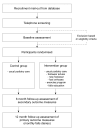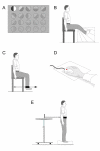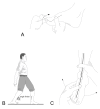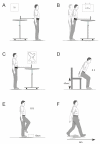Efficacy of a multifaceted podiatry intervention to improve balance and prevent falls in older people: study protocol for a randomised trial
- PMID: 19025668
- PMCID: PMC2613884
- DOI: 10.1186/1471-2318-8-30
Efficacy of a multifaceted podiatry intervention to improve balance and prevent falls in older people: study protocol for a randomised trial
Abstract
Background: Falls in older people are a major public health problem, with at least one in three people aged over 65 years falling each year. There is increasing evidence that foot problems and inappropriate footwear increase the risk of falls, however no studies have been undertaken to determine whether modifying these risk factors decreases the risk of falling. This article describes the design of a randomised trial to evaluate the efficacy of a multifaceted podiatry intervention to reduce foot pain, improve balance, and reduce falls in older people.
Methods: Three hundred community-dwelling men and women aged 65 years and over with current foot pain and an increased risk of falling will be randomly allocated to a control or intervention group. The "usual cae" control group will receive routine podiatry (i.e. nail care and callus debridement). The intervention group will receive usual care plus a multifaceted podiatry intervention consisting of: (i) prefabricated insoles customised to accommodate plantar lesions; (ii) footwear advice and assistance with the purchase of new footwear if current footwear is inappropriate; (iii) a home-based exercise program to strengthen foot and ankle muscles; and (iv) a falls prevention education booklet. Primary outcome measures will be the number of fallers, number of multiple fallers and the falls rate recorded by a falls diary over a 12 month period. Secondary outcome measures assessed six months after baseline will include the Medical Outcomes Study Short Form 12 (SF-12), the Manchester Foot Pain and Disability Index, the Falls Efficacy Scale International, and a series of balance and functional tests. Data will be analysed using the intention to treat principle.
Discussion: This study is the first randomised trial to evaluate the efficacy of podiatry in improving balance and preventing falls. The trial has been pragmatically designed to ensure that the findings can be generalised to clinical practice. If found to be effective, the multifaceted podiatry intervention will be a unique addition to common falls prevention strategies already in use.
Trial registration: Australian New Zealand Clinical Trials Registry: ACTRN12608000065392.
Figures








References
-
- Tinetti ME, Speechley M, Ginter SF. Risk factors for falls among elderly persons living in the community. N Engl J Med. 1988;319:1701. - PubMed
-
- Lord SR, Ward JA, Williams P, Anstey KP. An epidemiological study of falls in older community-dwelling women: the Randwick falls and fractures study. Aust J Public Health. 1993;17:240–245. - PubMed
-
- Lord SR, Sherrington C, Menz HB, Close JCT. Falls in older people: Risk factors and strategies for prevention. second. Cambridge: Cambridge university press; 2007.
-
- Baker SP, Harvey AH. Fall injuries in the elderly. Clin Geriatr Med. 1985;1:501–512. - PubMed
-
- Lord SR, Menz HB, Tiedemann A. A physiological profile approach to falls risk assessment and prevention. Phys Ther. 2003;83:237–252. - PubMed
Publication types
MeSH terms
LinkOut - more resources
Full Text Sources
Medical

